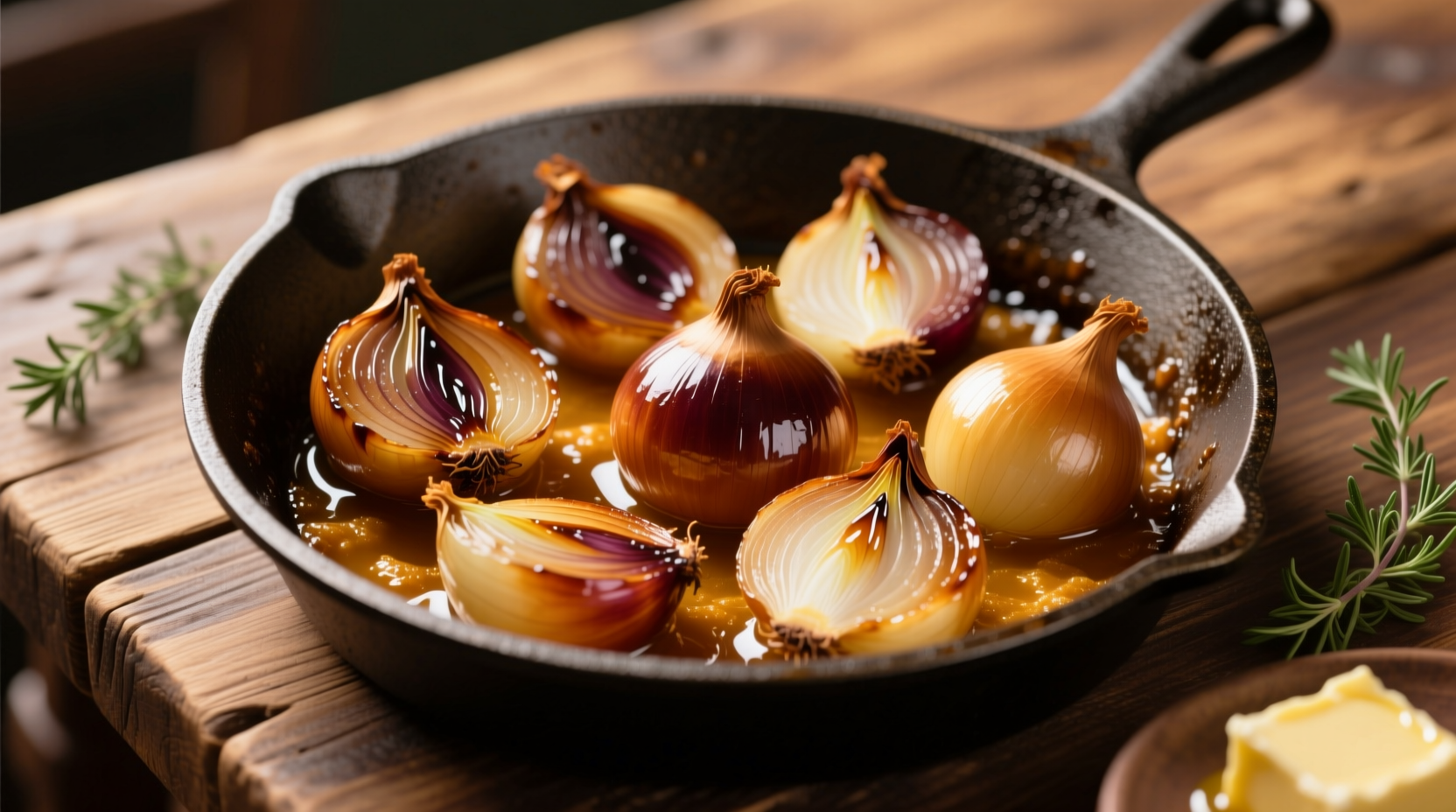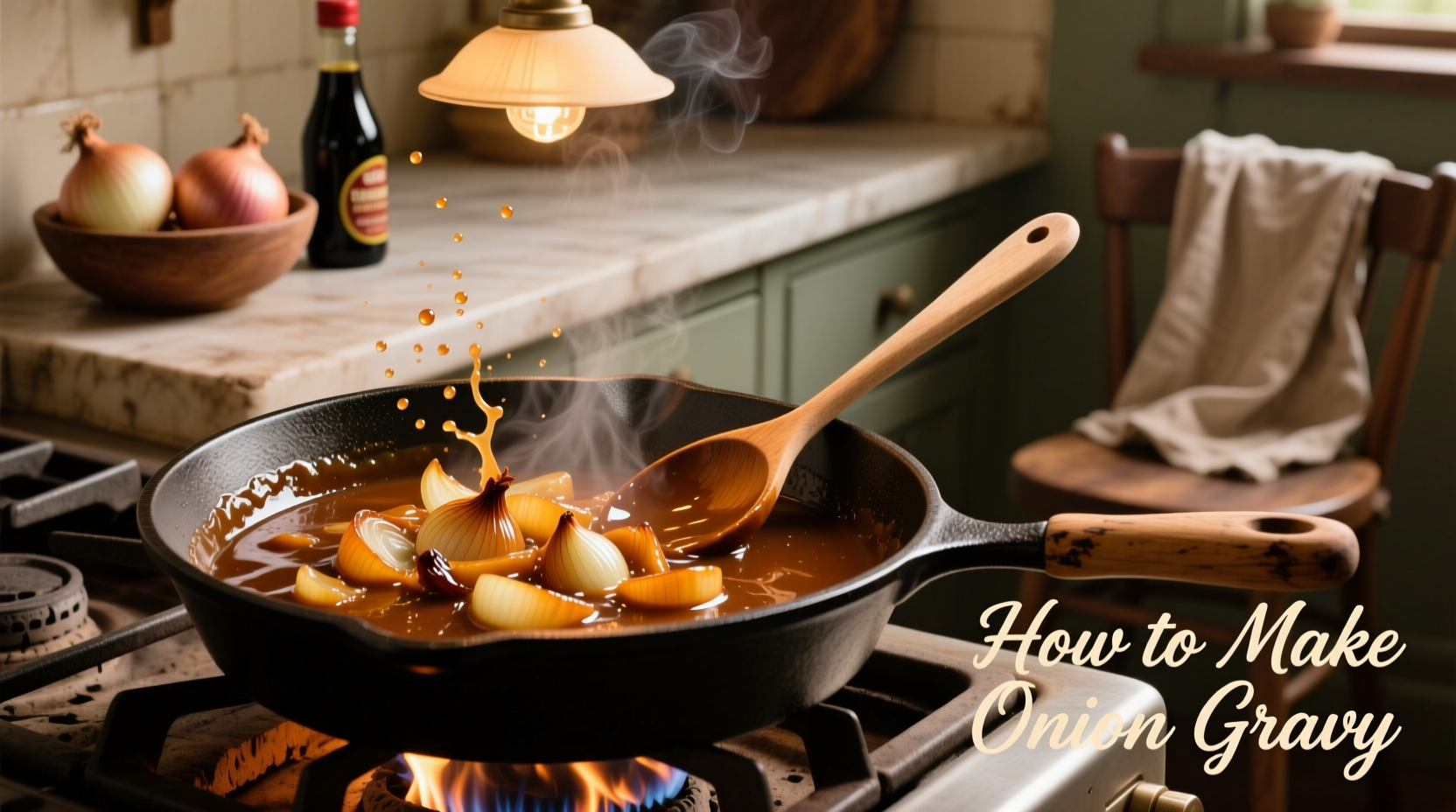Nothing elevates a simple roast dinner like a rich, deeply flavored onion gravy. While store-bought options exist, homemade onion gravy transforms ordinary meals into extraordinary experiences with its complex sweetness and savory depth. Master this essential culinary technique once, and you'll never settle for powdered mixes again.
Why This Onion Gravy Recipe Works Every Time
Professional chefs rely on three critical elements for perfect onion gravy: proper caramelization technique, balanced liquid ratios, and strategic thickening. Unlike quick fixes that use gravy powders, this method develops genuine flavor through the Maillard reaction—the chemical process that creates hundreds of flavor compounds when onions cook slowly over medium-low heat.

Your Onion Gravy Shopping List
Gather these simple ingredients before starting. Quality matters—use fresh onions and good stock for best results.
Essential Ingredients
- 4 large yellow onions (about 2 lbs), thinly sliced
- 3 tablespoons unsalted butter
- 2 tablespoons olive oil
- 2 cups quality beef or vegetable stock
- 1 tablespoon Worcestershire sauce
- Salt and freshly ground black pepper to taste
Optional Enhancements
- 1 teaspoon fresh thyme leaves
- 1 bay leaf
- 1 tablespoon balsamic vinegar
- 1/4 cup red wine for deglazing
| Onion Type | Flavor Profile | Best For | Cooking Time |
|---|---|---|---|
| Yellow Onions | Sweet, robust | Classic gravy base | 25-30 minutes |
| Shallots | Milder, delicate | Fine dining applications | 20-25 minutes |
| Red Onions | Sharp, slightly bitter | Vibrant color, bold flavor | 25 minutes |
| White Onions | Crisp, pungent | Mexican-inspired gravies | 20-25 minutes |
Step-by-Step: Crafting Perfect Onion Gravy
Phase 1: The Critical Caramelization (25-30 minutes)
- Combine butter and olive oil in a heavy skillet over medium-low heat
- Add sliced onions and stir to coat with fat
- Cook uncovered, stirring every 5 minutes, until onions turn deep golden brown
- Reduce heat if onions brown too quickly—patience creates complex flavor
- Scrape browned bits from pan bottom (these are flavor gold)
Pro Tip: Sprinkle 1/2 teaspoon of sugar during cooking to accelerate caramelization without burning. This technique, documented in BBC Good Food's caramelization guide, helps develop richer flavor faster.
Phase 2: Building Flavor Depth (5 minutes)
- Add Worcestershire sauce and optional wine (if using)
- Scrape pan thoroughly to incorporate all browned bits
- Simmer until liquid reduces by half
- Add herbs like thyme or bay leaf at this stage
Phase 3: Creating the Perfect Consistency (10 minutes)
- Pour in stock while stirring constantly
- Bring to gentle simmer and cook 5-7 minutes
- For thicker gravy, mix 1 tablespoon cornstarch with 2 tablespoons cold water and stir in
- Season with salt and pepper—remember stock contains salt
- Strain through fine mesh sieve for ultra-smooth texture (optional)
Avoid These Common Onion Gravy Mistakes
- Rushing caramelization: High heat burns onions instead of caramelizing them
- Overcrowding the pan: Causes steaming instead of browning—cook in batches if needed
- Using cold stock: Always add warm or hot stock to maintain cooking temperature
- Skipping deglazing: Those browned bits contain concentrated flavor
- Over-thickening: Gravy continues to thicken as it cools—aim for slightly thinner consistency
Onion Gravy Through the Ages
Onion gravy's evolution reflects culinary history. Originally developed in 18th century France as "sauce aux oignons," this technique was documented in Marie-Antoine Carême's 1833 cookbook L'Art de la Cuisine Française. British cooks adopted the method during the Victorian era, simplifying it for everyday use. The 1950s saw the rise of instant gravy mixes, but professional kitchens maintained the traditional slow-cooked approach. Today's chefs blend historical techniques with modern understanding of flavor chemistry, creating gravies with unprecedented depth.
Serving Suggestions & Storage
Onion gravy shines with roast beef, Yorkshire puddings, and mashed potatoes. For vegetarian versions, substitute vegetable stock and omit Worcestershire sauce (which contains anchovies).
Storage: Keep in airtight container in refrigerator for up to 5 days or freeze for 3 months. Reheat gently over low heat, adding small amounts of stock if too thick.
Variations for Every Occasion
- French Onion Gravy: Add 1/4 cup cognac and Gruyère cheese for steak au poivre
- British Pub Style: Use dark beer instead of wine for robust flavor
- Vegetarian Option: Substitute mushroom stock and add soy sauce for umami
- Quick Weeknight Version: Use pre-caramelized onions (found in freezer section) with homemade stock
Frequently Asked Questions
How long should I cook onions for perfect gravy?
For optimal flavor, cook onions 25-30 minutes until deep golden brown. Rushing this process (under 15 minutes) yields sharp, raw onion flavor. Professional chefs at Le Cordon Bleu teach that proper caramelization develops over 25 minutes at medium-low heat—any less misses crucial flavor development stages.
Can I make onion gravy without stock cubes?
Absolutely. The best onion gravy uses homemade stock, but quality store-bought stock works well too. Avoid stock cubes which often contain excessive salt and artificial flavors. For authentic flavor, simmer onions with water and a Parmesan rind—this creates natural umami without processed ingredients, as recommended by the Culinary Institute of America's flavor development guidelines.
Why is my onion gravy bitter?
Bitterness usually comes from burned onions or overcooked fond. If onions blacken during caramelization, start over—burnt bits transfer bitterness. To fix slightly bitter gravy, add 1/2 teaspoon sugar or 1 tablespoon balsamic vinegar to balance flavors. The University of California's food science department confirms that acids and sugars effectively counteract bitterness through flavor chemistry interactions.
How do I thicken onion gravy without lumps?
Create a smooth slurry by mixing 1 tablespoon cornstarch with 2 tablespoons cold water before adding to hot gravy. Whisk constantly while pouring slowly. For traditional thickening, reduce gravy uncovered for 5-7 minutes. Professional kitchens often use a beurre manié (equal parts butter and flour kneaded together) added gradually while whisking—this method prevents lumps better than flour alone, according to Chef Thomas Keller's The French Laundry Cookbook.











 浙公网安备
33010002000092号
浙公网安备
33010002000092号 浙B2-20120091-4
浙B2-20120091-4